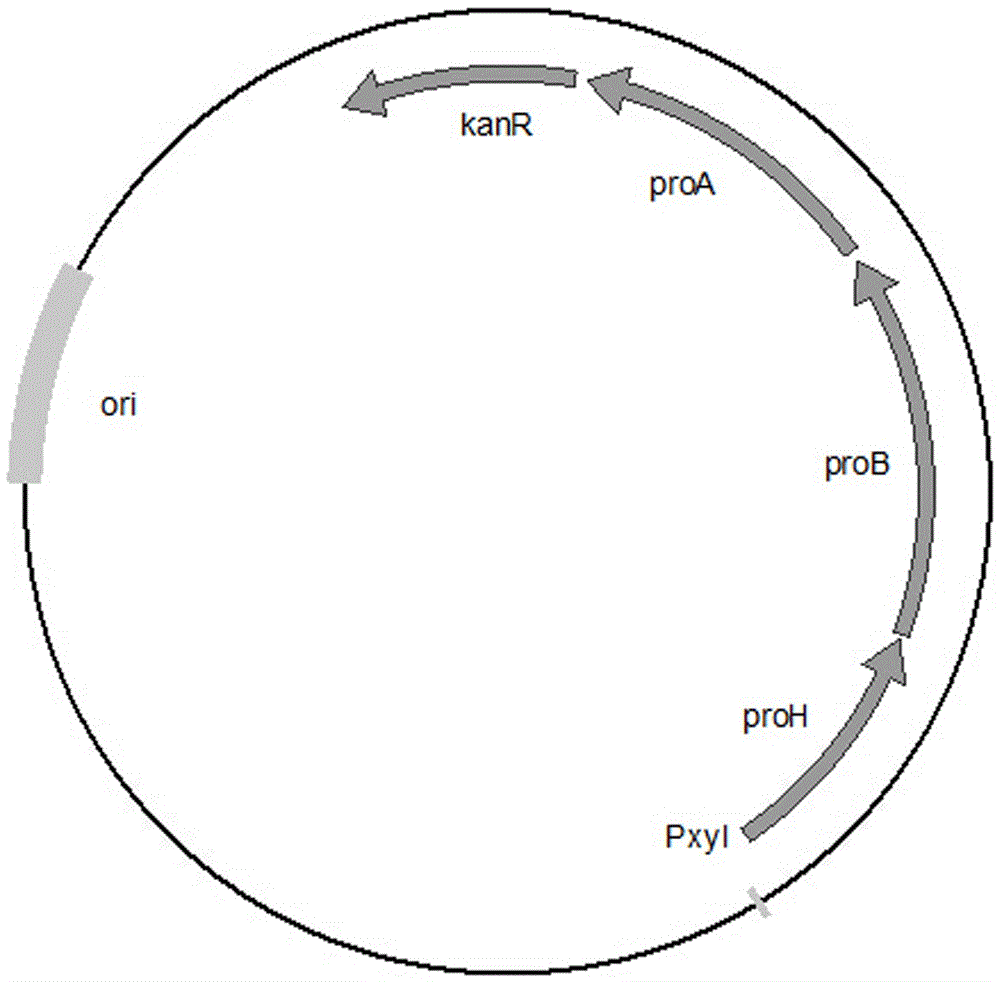Recombination strain for producing trans-4-hydroxy-L-proline and building and application of recombination strain
A technology of recombinant strains and proline, applied in the direction of recombinant DNA technology, microorganism-based methods, bacteria, etc., can solve the problems of increasing the amount of acid and alkali, increasing the production cycle, environmental problems, etc., to increase production and reduce the discharge of three wastes , The effect of convenient separation and purification
- Summary
- Abstract
- Description
- Claims
- Application Information
AI Technical Summary
Problems solved by technology
Method used
Image
Examples
Embodiment 1
[0031] Embodiment 1: Cloning of L-proline hydroxylase gene and its promoter
[0032] 1. Synthesize Pxyl+proH according to the L-proline hydroxylase gene proH sequence GenBank: D78338.1 (shown in SEQ ID NO.1) and the Bacillus subtilis xylanase promoter Pxyl sequence (shown in SEQ ID NO.2) Fragment with EcoRI and KpnI sites added at both ends (shown in SEQ ID NO.3);
[0033] 2. Digest Pxyl+proH with EcoRI and KpnI, wherein, enzyme digestion system: 43 μL of DNA, 5 μL of buffer, 1 μL of each of EcoRI and KpnI, and incubate at 37°C for 3 hours. Electrophoresis detection and recovery for future use.
[0034] 3. Cultivate Escherichia coli containing the pUC18 plasmid, and extract the plasmid. The extraction method is operated according to the kit instructions. The plasmid was double-digested with EcoRI and KpnI, the restriction system was the same as above, detected by electrophoresis and recovered for later use.
[0035] 4. Use T4 ligase to connect Pxyl+proH and carrier pUC18 DN...
Embodiment 2
[0037] Embodiment 2: Cloning of L-glutamate kinase gene proB and L-glutamyl phosphate reductase gene proA gene
[0038] 1. Use the total DNA of Escherichia coli DH5α strain as a template, and use primer F-proB: TAT GGTACC AACTGCCGCTAGGCTTGCTG (shown in SEQ ID NO.4) and R-proA: GTA GGATCC CGTCAATGGCCTTGTGAATC (shown in SEQ ID NO.5) was amplified to obtain the proB+proA gene fragment. Among them, the PCR reaction system includes: template 1μL Escherichia coli genomic DNA, 1μL dNTP (10mmol / L), 2μmol / LMgCl 2 , 0.5 μmol / Lprimers, 5 μL 10×PCRbuffer, 3UKOD DNA polymerase (purchased from TOYOBO). The PCR reaction conditions include: pre-denaturation at 94°C for 5 min; denaturation at 94°C for 30 s, annealing at 55°C for 40 s, extension at 68°C for 2 min, 25 cycles; 68, 10 min.
[0039] 2. Using the operation similar to Example 1, use KpnI and BamHI to double-enzyme-cut proB+proA, connect with the same double-enzyme-digested pUC18-pxyl-proH plasmid, transform Escherichia coli DH5α...
Embodiment 3
[0040] Embodiment 3: the cloning of kanamycin resistance gene
[0041] 1. Take the template plasmid pKD4 as the template, and use the primer F-kanR:CAT GGATCC TGTAGGCTGGAGCTGCTTCG (shown in SEQ ID NO.6) and R-kanR:GAC AAGCTT ATGGGAATTAGCCATGGTCC (shown in SEQ ID NO.7) was amplified to obtain the kanamycin resistance gene fragment kanR, and the PCR conditions were the same as in Example 1.
[0042] 2. Using operations similar to Example 1, use BamHI and HindIII to double-enzyme-cut kanR, connect with the same double-enzyme-digested pUC18-pxyl-proH-proB-proA plasmid, transform Escherichia coli DH5α, and obtain a recombinant plasmid. In the present invention named "pUC18-pxyl-proH-proB-proA-kanR";
PUM
 Login to View More
Login to View More Abstract
Description
Claims
Application Information
 Login to View More
Login to View More - R&D
- Intellectual Property
- Life Sciences
- Materials
- Tech Scout
- Unparalleled Data Quality
- Higher Quality Content
- 60% Fewer Hallucinations
Browse by: Latest US Patents, China's latest patents, Technical Efficacy Thesaurus, Application Domain, Technology Topic, Popular Technical Reports.
© 2025 PatSnap. All rights reserved.Legal|Privacy policy|Modern Slavery Act Transparency Statement|Sitemap|About US| Contact US: help@patsnap.com


